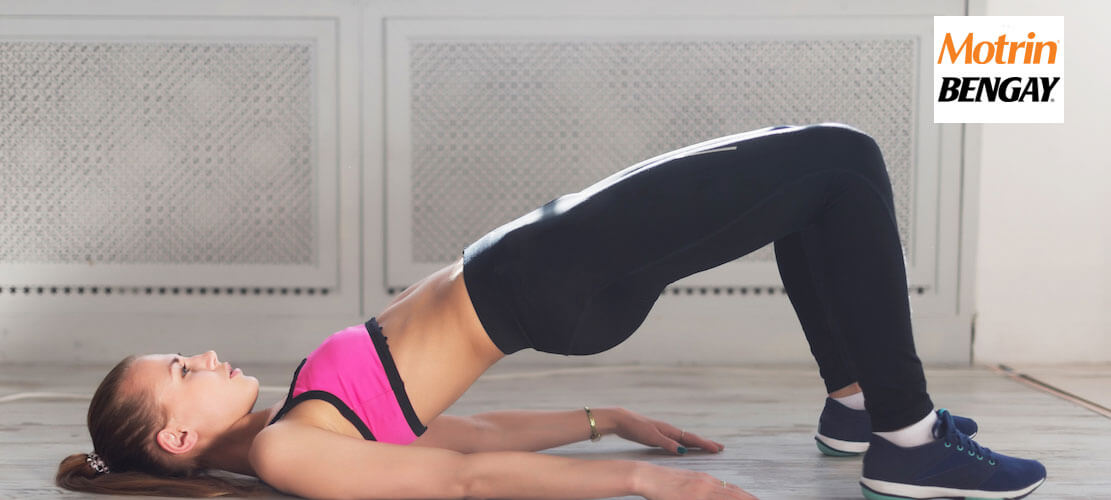Rest and Recovery Advice From a Major League Strength Coach

This article is sponsored by our partner, Motrin & Bengay.
Pro baseball players train their bodies in countless ways—from cardio to weightlifting—to compete at the major league level. But it’s their aggressive strength and conditioning program that helps them stay injury free and build strength in the right places. And although Spartan races and baseball don’t seem to have much in common, Spartans should take a leaf from the baseball training book. Believe it or not, the concepts of pro baseball workouts can (and should!) be applied to Spartans. Proper strength training and conditioning will not only help fix posture issues (common in runners), but also strengthen the core and improve balance, mobility, and stability to get you through each obstacle. “We constantly talk about posture, joint integrity, and tensile strength,” says Brandon McDaniel, the director of athletic development for the Los Angeles Dodgers. “As you run or do gym workouts, you lose a little bit of posture and muscular/joint balance. So the proper strength training can help all sides of the body to move well and counteract these issues, which can manifest into injury.”
The Case for Strength and Conditioning Training
McDaniel says strength and conditioning training as an active form of recovery is so much healthier than passive recovery, à la Netflix bingeing on the couch. “Strength and conditioning mobilizes the blood in your body, but if you just sit and rest, all of that stiffness builds up on you,” says McDaniel. “We get sore because we’re not getting enough nutrients to the right places. But strength and conditioning allows for the lubrication of joints and gives you techniques to build strength in the most important muscle groups.” So instead of wasting your off days, McDaniel recommends incorporating a workout that focuses on your glutes, abdominals, obliques, and scapulae to maximize your recovery. “The better you can use your glutes, the more you take pressure off the low back. Also, your hips will become a little less tight and your shoulders will be more open,” says McDaniel. “This is critical because lots of people get shut down from working out by low back or shoulder pain.” Tight hamstrings and IT bands can also contribute to pain like this. So the key to fighting tightness comes from contracting and relaxing exercises that target opposing muscle groups, says McDaniel. “You can do these in a hotel, a plane, bus—basically anywhere. But if you have a tight quad, contracting your hamstrings can help alleviate that pressure and promote blood flow to help loosen up that muscle,” says McDaniel. “I don’t believe in stretching your hamstrings, per se. A lot of people who have tight hamstrings think their muscle belly is short, but that’s not true. The symptom actually comes from overcompensating for a lack of core strength.”
Importance of Proper Fitness Education
McDaniels says that when it comes to strength and conditioning training, the toughest obstacle for most people isn’t a lack of motivation to work out, but rather a lack of education on how to work out. “When you’re pulling workouts out of a magazine or off the web, it can be a crapshoot. Education should be the number-one priority,” says McDaniel. “At the Dodgers, we have a common goal: all of the players are striving to be better baseball players. But achieving that needs to start with educating them on why we do what we do. They need to understand why their hips and ankles need to be stable and why the core needs to be strong. Even why we wear zero-drop shoes for better ankle dorsiflexion.”
When you translate the strength and conditioning concepts of a pro baseball team to a Spartan training program, it’s all about taking the time to properly warm up and cool down, and about supplementing running with bodyweight exercises. Do this, and you’ll see a big change in your running game over the long term. “Really good athletes, as they get older, focus as much on their movement quality as they do their movement quantity,” says McDaniel. “Strength and conditioning training can help you age better as an athlete and keep your joint health very young.”
Brandon McDaniel’s Spartan Spring Stability and Mobility Workout
With strength and conditioning, many endurance athletes skimp on their warm-up and cool down in favor of a longer, harder workout. But in reality, pre- and post-workout preparation is just as important as getting quality reps or cardio. “Everyone has a habit, especially when they train on their own, to not take their warm-ups and cool downs seriously,” says McDaniel. “But 10 minutes per day goes a long way. If you foam roll or get some solid stretching every single day for at least 10 minutes, over the course of a year it adds up to quite a bit of time. And 10 minutes per day of recovery work can add years to your running or fitness career.” Try McDaniel’s go-to exercises below to build strength in the larger supportive muscle groups, increase stability and mobility, and prevent injury overall. Tackle this circuit at home or in the gym, or even modify it for your hotel room. If you don’t have access to TRX suspension straps, do three planks or forearm planks instead of the TRX row, working up to holding for two or three minutes.
Repeat This Strength & Conditioning Circuit 3-5 Times
#1 Rear foot elevated split squats (10 repetitions on each side)
Shift your weight onto your right foot and place your left foot behind you on a bench or stair that elevates your foot so your left knee is bent at close to 45 degrees. Exhale, engage your abdominals and lower your left knee to the floor. Inhale to come back up. Repeat 10 times, then switch to the other side. Work with your own body weight, or take it up a level by holding light dumbbells (10 pounds or so) or a medicine ball, or by wearing a weight vest. Add an extra balance challenge by using a narrow stance and holding a medicine ball up overhead as you lunge. Note that when you use a wider stance you’ll work your glutes, and with a narrower stance you’ll work your quads, so mix it up each day.
#2 Dynamic bridges and one-legged bridges (five dynamic bridges and two one-legged bridges on each side)
For dynamic bridges, lie down on your back, placing your feet hip-width apart. Press your hands down along your sides, and inhale to send your hips upward to the ceiling. Tuck your sacrum, relax your glutes, and press down into the four corners of your feet to use the strength of your legs to find opening through the upper chest. Exhale to lower, touching each vertebra to the floor. Repeat for four more rounds. Then go back up into the bridge. Ground down through your right foot, and inhale as you raise your left leg to the ceiling. Hold for 30 seconds and switch sides. Repeat once more on each side.
“Your glute is the primary hip extender, not the hamstrings as most people think,” says McDaniel. “So hold the weight in your hands to activate your core and build strength in your hips and legs.”
#3 TRX row (10 repetitions)
Shorten the TRX straps all the way. Stand back from the straps with your body in a straight line, as if you were in a vertical plank and your hands in front of you. Keep your arms straight and walk your feet forward until your weight starts to come onto the straps. This is your starting position. Keep your palms facing each other throughout the lift. Pull your shoulder blades back and down away from your ears. Then pull your torso toward your hands, keeping your elbows close to your body. Your body should remain rigid and your palms and wrists should stay neutral. Lower your body back to the starting position and repeat for nine more repetitions. If it’s too easy, move your feet farther forward. If it is too difficult with correct form, walk your feet back. The key? Proper form. Keep a tight core, a straight body, and your palms facing each other the whole time.
#4 Half-kneeling cable lift (10 each side)
For a solid move to work your middle and low back and strengthen your triceps, lats, and shoulders, try the half-kneeling cable lift. Place the rope or long bar handle on the cable machine and lower it to the lowest setting. Kneel on your left knee in a lunge position with your left side facing the cable machine. Grab the top of the rope or bar with your right hand and the bottom of it with your left hand in a wide grip (palms facing down). Keep your upper body straight but rotate your arms so that your left arm is up and out in front of you and your right arm rotates to the right, in a chopping motion low to high across the body. Bring your arms back down. Continue for nine more repetitions, then switch sides for 10 reps. “Running is a sagittal-plane dominant exercise, so we lose the ability to rotate when we overtrain our running muscles,” says McDaniel. “This exercise is important to counter that hunched posture runners tend to develop.”
#5 Quadruped arm opposite leg raises (10 each side)
The quadruped arm opposite leg raise strengthens your posterior core like no other. From tabletop position with a neutral spine, lift your left arm straight out in front of you, and your right leg straight out behind you. Point your left thumb to the ceiling and your right toes toward the floor. Curl your left elbow to your right knee, squeezing into your midline and engaging your abdomen. Repeat nine more times. Then switch sides for 10 repetitions. “The key with this one is to reach your lifted heel as far back as you can toward the wall behind you, and reach your opposite arm as far forward as you can,” says McDaniel. “Extension helps strengthen your back muscles and core.”
Bonus Strength and Conditioning Tip 1: Bent Knee Quad Foam Roll Release for Leg Recovery
Foam rolling your trigger points is a nice way to release tightness in the connective tissue. McDaniel says if you do one thing with the foam roller, make it bent knee quad rolling. Lie on top of the foam roller, placing it at the top of your thighs near your hip creases. Then bend your knees so your feet are parallel to the ceiling. Roll down your quad, moving slowly—about 30 seconds to a minute per inch, working toward just above your knee joint. When you find a trigger point, pause and flex and extend your knee so you can get into those tissues.
Bonus Strength and Conditioning Tip 2: Lacrosse Ball Pectoral Release for Better Posture
McDaniel also says, “Believe it or not, a lacrosse ball in the pectoral muscle goes a long way for runners, most of whom get so bound up because they’re hunched forward and tight.” Lie face down and place a lacrosse ball on a yoga block under your pectoral muscle. Flex and extend your shoulders, moving your arm up overhead and down by your side, breathing through the release of any trigger points.




